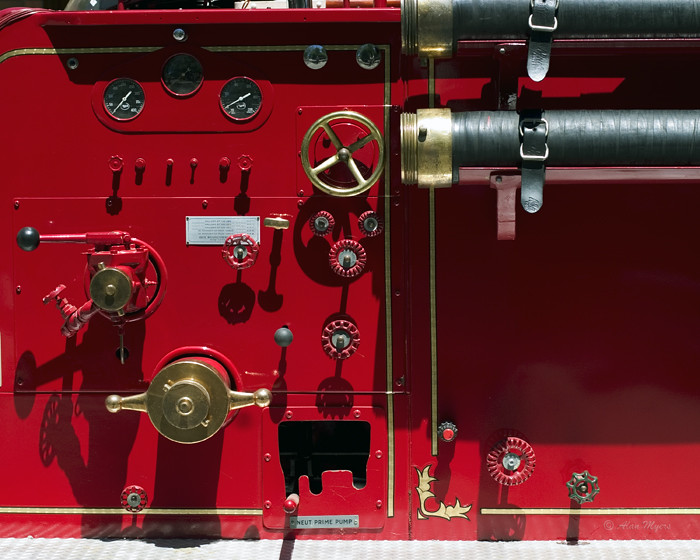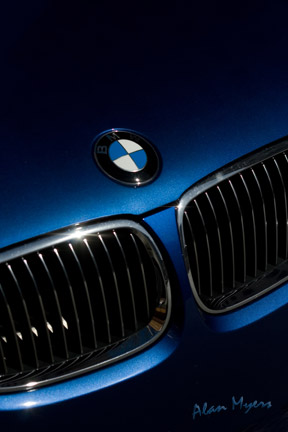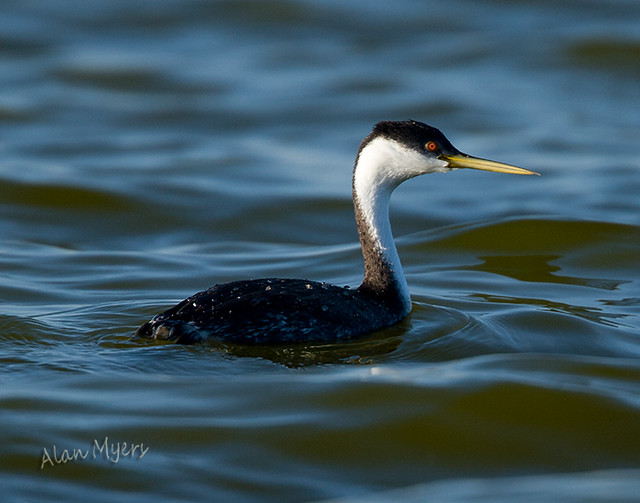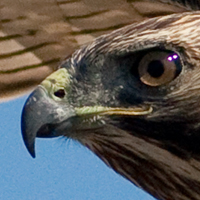Canon EOS 20D Back Button Focus
Sep 14, 2016 12:05:18 #
amfoto1
Loc: San Jose, Calif. USA
I've been using BBF on all my Canon since the film days (EOS-3, 1V and Elan 7E/EOS33).
On 20D it is done using one of the Custom Functions, to assign focus to the * button (which is normally used for AE Lock).
The 40D was one of the first models to have an "AF On" button added, but if you used the BG-E2/E2N battery grip on it (or the 50D), you still had to use the * button for BBF because that grip was never updated with an "AF On" button to match the cameras it was used upon.
When you set the Custom Function for BBF with those earlier models, you are given a choice: AE Lock all the time or no AE Lock (AE "unlocked" all the time). I recommend the latter. There simply are a lot of times when you don't want AE Lock, when using it every time you press the shutter release button will cause exposure problems. If you do need AE Lock, you have a choice of temporarily disabling BBF in the Custom Function so that the * button once again provides AE Lock function.... or just make a note of your exposure settings, switch to M (manual) mode and dial those settings in. That gives the exact same effect as AE Lock. (Maybe even better because AE Lock will cancel itself after something like 15 seconds... while switching to M and making the settings manually will remain that way until you change it.)
In 20D (and some other Canon models) BBF is set up with Custom Function 4 (C.Fn-04) "Shutter button/AE lock button". There are four possible settings... I recommend "3. AE/AF, no AE Lock".
Again, on 40D and 50D with a battery grip, you need to do the same setup (because there's no AF On button on the grip).
On 40D and 50D without grip and on later cameras that have the AF On button, BBF is already set up at that rear button and to use it you instead just unassign AF from the shutter release.
On later models you have choice of swapping function of the AF On and * buttons. I do that on my cameras for several reasons... First, I still use some older cameras that only have the * button and am in the habit of using that for BBF. But also the * button is larger, more prominent and closer to one's thumb on most Canon models that have both buttons. I just find it easier to use.
One of the main purposes of using BBF, of separating focus function from the shutter release, is so that you can use AI Servo as your default focusing mode... with both stationary and moving subjects. This is rather than having to switch back and forth between AI Servo for moving subjects and One Shot for stationary. Using BBF makes you "ready for anything" instantly, rather than fumbling with changing your focus setup while the subject is getting away.
Without BBF, there are times you can't use AI Servo... for example if using a single AF point with a Focus & Recompose method to shoot a stationary subject.
With BBF you can Focus & Recompose with AI Servo simply by pressing the button to achieve focus, then lifting off the button so it remains focused at that point when you recompose.
You also can use BBF to "dodge" subjects that momentarily come between you and your subject, so that the camera doesn't refocus on the obstruction.
Being able to use AI Servo as your default mode also is beneficial with a lot of modern zooms, which are varifocal designs that don't maintain focus when the focal length is changed. If your Canon is in AI Servo mode it will automatically correct focus "on-the-fly". If instead your camera is set to One Shot, you first need to know whether or not your lens is varifocal, and if it is you need to remember to lift off the button and refocus any time you zoom the lens.
One downside to AI Servo is that there's no "Focus Confirmation" possible.... i.e. no "Green LED" or flashing AF point in the viewfinder or audible "beep" telling you that focus has been achieved. This is only possible in One Shot, which stops and locks once focus is achieved. Since AI Servo is continuous focus, i.e. never stops and locks (unless you cause it to manually when you release the button), there's nothing to confirm and no way to give Focus Confirmation. Some people find it a takes a little time to get accustomed to working without Focus Confirmation, using AI Servo as your default mode. You have to learn to trust the camera and yourself.
By the way, some people disable the Focus Confirmation "beep". I make a point of leaving it on most of the time because it immediately tells me when I've got the camera set to One Shot mode. (I often hear peoples' cameras "beeping" while they're shooting moving subjects.... That instantly tells me they've got the wrong focus mode set and I can guarantee you the vast majority of their shots are missing focus... and they're probably blaming the camera and lens.)
On 20D it is done using one of the Custom Functions, to assign focus to the * button (which is normally used for AE Lock).
The 40D was one of the first models to have an "AF On" button added, but if you used the BG-E2/E2N battery grip on it (or the 50D), you still had to use the * button for BBF because that grip was never updated with an "AF On" button to match the cameras it was used upon.
When you set the Custom Function for BBF with those earlier models, you are given a choice: AE Lock all the time or no AE Lock (AE "unlocked" all the time). I recommend the latter. There simply are a lot of times when you don't want AE Lock, when using it every time you press the shutter release button will cause exposure problems. If you do need AE Lock, you have a choice of temporarily disabling BBF in the Custom Function so that the * button once again provides AE Lock function.... or just make a note of your exposure settings, switch to M (manual) mode and dial those settings in. That gives the exact same effect as AE Lock. (Maybe even better because AE Lock will cancel itself after something like 15 seconds... while switching to M and making the settings manually will remain that way until you change it.)
In 20D (and some other Canon models) BBF is set up with Custom Function 4 (C.Fn-04) "Shutter button/AE lock button". There are four possible settings... I recommend "3. AE/AF, no AE Lock".
Again, on 40D and 50D with a battery grip, you need to do the same setup (because there's no AF On button on the grip).
On 40D and 50D without grip and on later cameras that have the AF On button, BBF is already set up at that rear button and to use it you instead just unassign AF from the shutter release.
On later models you have choice of swapping function of the AF On and * buttons. I do that on my cameras for several reasons... First, I still use some older cameras that only have the * button and am in the habit of using that for BBF. But also the * button is larger, more prominent and closer to one's thumb on most Canon models that have both buttons. I just find it easier to use.
One of the main purposes of using BBF, of separating focus function from the shutter release, is so that you can use AI Servo as your default focusing mode... with both stationary and moving subjects. This is rather than having to switch back and forth between AI Servo for moving subjects and One Shot for stationary. Using BBF makes you "ready for anything" instantly, rather than fumbling with changing your focus setup while the subject is getting away.
Without BBF, there are times you can't use AI Servo... for example if using a single AF point with a Focus & Recompose method to shoot a stationary subject.
With BBF you can Focus & Recompose with AI Servo simply by pressing the button to achieve focus, then lifting off the button so it remains focused at that point when you recompose.
You also can use BBF to "dodge" subjects that momentarily come between you and your subject, so that the camera doesn't refocus on the obstruction.
Being able to use AI Servo as your default mode also is beneficial with a lot of modern zooms, which are varifocal designs that don't maintain focus when the focal length is changed. If your Canon is in AI Servo mode it will automatically correct focus "on-the-fly". If instead your camera is set to One Shot, you first need to know whether or not your lens is varifocal, and if it is you need to remember to lift off the button and refocus any time you zoom the lens.
One downside to AI Servo is that there's no "Focus Confirmation" possible.... i.e. no "Green LED" or flashing AF point in the viewfinder or audible "beep" telling you that focus has been achieved. This is only possible in One Shot, which stops and locks once focus is achieved. Since AI Servo is continuous focus, i.e. never stops and locks (unless you cause it to manually when you release the button), there's nothing to confirm and no way to give Focus Confirmation. Some people find it a takes a little time to get accustomed to working without Focus Confirmation, using AI Servo as your default mode. You have to learn to trust the camera and yourself.
By the way, some people disable the Focus Confirmation "beep". I make a point of leaving it on most of the time because it immediately tells me when I've got the camera set to One Shot mode. (I often hear peoples' cameras "beeping" while they're shooting moving subjects.... That instantly tells me they've got the wrong focus mode set and I can guarantee you the vast majority of their shots are missing focus... and they're probably blaming the camera and lens.)
Sep 14, 2016 12:22:31 #
amfoto1
Loc: San Jose, Calif. USA
Fotoartist wrote:
A big shooter in my camera club still uses a Canon 20D on his trips all over the world. The Canon 20D is well over 10 years old. It's an 8MP noisy crop sensor camera. When he exhibits his work the subject matter is great but technically the photos could be called horrible by today's standards. Can someone please tell me the rationale for still using this camera?
Yeah, those early DSLRs had really lousy image quality.... Like these from my even older, 6MP Canon 10D:



Or these from one of my 30D (which uses the exact same 8MP sensor as 20D):






Pretty crappy and horrible stuff, huh?

Could it be that your acquaintance in the camera club is more into taking photos, than he is into buying the latest and greatest gear? Maybe he'd rather spend his money on airplane tickets and hotels than on cameras?
A friend of mine shoots with a 100 year old Kodak lens on an 11x14 sheet film camera and makes prints from the negs with an ancient, horizontal enlarger that takes up most of a one car garage. Some of his work is hanging in museums....
"New" is not necessarily "better".
I never had any complaints about the image quality from my older Canon. I mostly upgraded for other reasons: Self-cleaning sensors (had to clean the old cameras too often), better AF systems, faster frame rates, higher usable ISOs. Yes, higher resolution cameras allow for bigger prints and/or heavier cropping, if needed. And the old 10D was hard on batteries... didn't get a lot of shots per charge and was slow to wake up from sleep mode. Missed some shots because of that.
Sep 14, 2016 12:28:55 #
amfoto1 wrote:
Yeah, those early DSLRs had really i lousy /i im... (show quote)
Agree 100%...it's not the camera that makes a great photo...it's the person behind it! Thanks for sharing!
Sep 14, 2016 12:41:02 #
You're images look good Alan as I implied most images would in small web based viewing. Have you made a large 13x19 print of these, examined them at arm's length and been happy with the print quality?
I agree with you that some people are more interested in getting the image than about having the newest gear. To me, getting the image is the main goal after all. But, would you travel to Africa and South America now with a 10D and a 30D?
I agree with you that some people are more interested in getting the image than about having the newest gear. To me, getting the image is the main goal after all. But, would you travel to Africa and South America now with a 10D and a 30D?
Sep 14, 2016 12:53:26 #
Fotoartist wrote:
You're images look good Alan as I implied most images would in small web based viewing. Have you made a large 13x19 print of these, examined them at arm's length and been happy with the print quality?
I agree with you that some people are more interested in getting the image than about having the newest gear. To me, getting the image is the main goal after all. But, would you travel to Africa and South America now with a 10D and a 30D?
I agree with you that some people are more interested in getting the image than about having the newest gear. To me, getting the image is the main goal after all. But, would you travel to Africa and South America now with a 10D and a 30D?
I really don't understand your point. Most people that are seriously interested in their work will get the best equipment available or affordable to them to the level they wish or are able to work. For those that have financial limitations to navigate it is a different decision process than you seem to suggest. Of course there is better / more modern equipment available. That is obvious. Does everybody need it to produce decent work? No. Does everybody need to print very large images? No.
Alan's example demonstrates that worthwhile things can be done with older equipment for those that have some skill and the inclination. We have plenty of other discussions about the relative merits of equipment. What does this have to do with BBF, and especially the OP's original question?
Perhaps you are 'an artist' and don't live in the same world as most on UHH!
Sep 14, 2016 13:03:04 #
amfoto1
Loc: San Jose, Calif. USA
Fotoartist wrote:
You're images look good Alan as I implied most images would in small web based viewing. Have you made a large 13x19 print of these, examined them at arm's length and been happy with the print quality?
I agree with you that some people are more interested in getting the image than about having the newest gear. To me, getting the image is the main goal after all. But, would you travel to Africa and South America now with a 10D and a 30D?
I agree with you that some people are more interested in getting the image than about having the newest gear. To me, getting the image is the main goal after all. But, would you travel to Africa and South America now with a 10D and a 30D?
Yes, I actually have made and sold quite a few 11x14 and 13x19 prints from numerous images made with my old 10D and 30D cameras, including some of the above and this one (30D)...

In fact, that's close to the upper size limit and you have to "fill the viewfinder" of those lower res cameras to print that large.... can't both crop an image a lot and make a larger print from it. For example, I tried to avoid converting a horizontal image from 6MP or 8MP camera into a vertical 8x10 or 11x14... that was just too heavy a crop for the image to hold up. With later 15MP, 18MP and 20MP APS-C cameras, no problem.... I can both crop and make moderately large prints from them
The largest prints I recall making from 8MP 30D were a pair of 16x20" horse portraits. They still look great hanging over a friend's fireplace.
No, I likely would not travel with my trusty old 10D any more... but mainly because I don't need to, can afford and want some of the other conveniences and features of newer DSLRs I now use (much better battery life, much higher usable ISO, faster frame rates, Flicker Free mode, self-cleaning sensors, usable Live View auto focus, built-in level, yada, yada). Among a few other things, I upgraded from 10D to 30D because 10D couldn't record RAW + JPEG and I needed that for the work I was doing at the time.
But, yes, at times I might want to be able to print 18x24 or larger, if needed... and a camera with more than 8MP resolution is definitely desirable for that, too (tho you might be surprised what's possible with careful up-rezzing in Photoshop, esp. with a plug-in such as Genuine Fractals). Or I may want to be able to both crop a bit and still print fairly large... such as this shot made with a 21MP full frame 5DII, that's both been cropped and printed 16x20":



It's not just resolution, either. Canon cameras 30D and prior were 12 bit.... 40D and all later ones are 14 bit. This makes for a bit more enlargeable/workable images too.
But, not everyone needs high resolution. A ton of 8MP camera images will fit onto a 2GB memory card and they won't fill up a laptop's hard drive nearly as fast as 20MP and larger will. a lot of people today never print their images... only ever display them online where much lower resolution is more than adequate.
Also, IMO a lot of people are overly critical of their images. Examining an 18MP or 20MP camera's image file at 100% on most modern computer monitors is like making a 40x60" print from it, then viewing it from 18 or 20" away... That's way closer scrutiny than necessary, in most cases. Of course it looks like crap! Even "Mona Lisa" or any other great work hanging in the Louvre will look awful viewed up close, too!
EDIT: I agree... it is always best, if possible, to evaluate sharpness, focus and other image qualities in a print done with a photo quality printer, preferably on smooth, matte paper. That will most honestly show any image short-comings. And, up to about 13x19, that's quite possible with an 8MP 20D camera.
But I sort of glossed over a couple other key factors, which are that it's also important to use good glass on that camera as well as good techniques to get the best out of camera and lens.
Sep 14, 2016 13:20:39 #
Good looking stuff Alan. Can't argue with the way you have presented your images here.
I'm going to end with this, if you really want to judge your equipment and technique as a photographer, you have to make a large print (13x19, 16x20), set in stone, so to speak, and examine it at arms length in the real world, not the virtual one.
I'm going to end with this, if you really want to judge your equipment and technique as a photographer, you have to make a large print (13x19, 16x20), set in stone, so to speak, and examine it at arms length in the real world, not the virtual one.
If you want to reply, then register here. Registration is free and your account is created instantly, so you can post right away.


